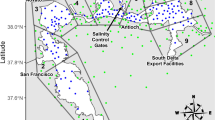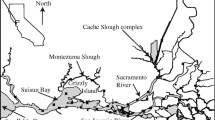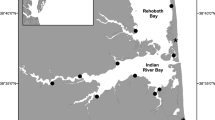Abstract
Investigating the effects of environmental, biological, and anthropogenic covariates on fish populations can aid interpretation of abundance and distribution patterns, contribute to understanding ecosystem functioning, and assist with management. Studies have documented declines in survey catch per unit effort (CPUE) of several fishes in the Sacramento-San Joaquin Delta, a highly altered estuary on the US west coast. This paper extends previous research by applying statistical models to 45 years (1967–2012) of trawl survey data to quantify the effects of covariates measured at different temporal scales on the CPUE of four species (delta smelt, Hypomesus transpacificus; longfin smelt, Spirinchus thaleichthys; age-0 striped bass, Morone saxatilis; and threadfin shad, Dorosoma petenense). Model comparisons showed that along with year, the covariates month, region, and Secchi depth measured synoptically with sampling were all statistically important, particularly in explaining patterns in zero observations. Secchi depth and predicted CPUE were inversely related for all species indicating that water clarity mediates CPUE. Model comparisons when the year covariate was replaced with annualized biotic and abiotic covariates indicated total suspended solids (TSS) best explained CPUE trends for all species, which extends the importance of water clarity on CPUE to an annual timescale. Comparatively, there was no empirical support for any other annualized covariates, which included metrics of prey abundance, other water quality parameters, and water flow. Top-down and bottom-up forcing remain important issues for understanding delta ecosystem functioning; however, the results of this study raise new questions about the effects of changing survey catchability in explaining patterns in pelagic fish CPUE.







Similar content being viewed by others
References
Akaike, H. 1973. Information theory as an extension of the maximum likelihood principle. In Second international symposium on information theory, ed. B.N. Petrov and F. Csaki, 267–281. Budapest: Akademiai Kiado.
Alpine, A.E., and J.E. Cloern. 1992. Trophic interactions and direct physical effects control phytoplankton biomass and production in an estuary. Limnology and Oceanography 37: 946–955.
Arthur, J.F., M.D. Ball, and S.Y. Baughman. 1996. Summary of federal and state water project environmental impacts in the San Francisco Bay-Delta Estuary, California. In San Francisco Bay: The Ecosystem, ed. J.T. Hollibaugh, 445–495. San Francisco: Pacific Division American Association for the Advancement of Science.
Atwater, B.F., S.G. Conrad, J.N. Dowden, C.W. Hedel, R.L. MacDonald, and W. Savage. 1979. History, landforms andvegetation of the estuary’s tidal marshes. In San Francisco Bay: The Urbanized Estuary, ed. T.J. Conomos, 347–385. San Francisco: Pacific Division American Association for the Advancement of Science.
Breitburg, D. 2002. Effects of hypoxia, and the balance between hypoxia and enrichment, on coastal fishes and fisheries. Estuaries 25: 767–781.
Brodziak, J., and W.A. Walsh. 2013. Model selection and multimodel inference for standardizing catch rates of bycatch species: a case study of oceanic whitetip shark in the Hawaii-based longline fishery. Canadian Journal of Fisheries and Aquatic Sciences 70: 1723–1740.
Buchheister, A., C.F. Bonzek, J. Gartland, and R.J. Latour. 2013. Patterns and drivers of the demersal fishcommunity in Chesapeake Bay. Marine Ecology Progress Series 481: 161–180.
Burnham, K.P., and D.R. Anderson. 2002. Model selection and multimodel inference: a practical information-theoretic approach. New York: Springer.
Chavez, F.P., J. Ryan, S.E. Lluch-Cota, and M. Niquen. 2003. From anchovies to sardines and back: multidecadal change in the Pacific Ocean. Science 299: 217–221.
Cohen, A.N., and J.T. Carlton. 1998. Accelerating invasion rate in a highly invaded estuary. Science 279: 555–558.
Connor, M.S., J.A. Davis, J. Leatherbarrow, B.K. Greenfield, A. Gunther, D. Hardin, T. Mumley, J.J. Oram, and C. Werme. 2007. The slow recovery of San Francisco Bay from the legacy of organochlorine pesticides. Environmental Research 105: 87–100.
Craig, J.K. 2012. Aggregation on the edge: effects of hypoxia avoidance on the spatial distribution of brown shrimp and demersal fishes in the Northern Gulf of Mexico. Marine Ecology Progress Series 445: 75–95.
Cury, P., and L. Shannon. 2004. Regime shifts in upwelling ecosystems: observed changes and possible mechanisms in the northern and southern Benguela. Progress in Oceanography 60: 223–243.
Diaz, R.J., and R. Rosenberg. 2008. Spreading dead zones and consequences for marine ecosystems. Science 321: 926–929.
Drinkwater, K.F., G. Beaugrand, M. Kaeriyama, S. Kim, G. Ottersen, R.I. Perry, H. Pörtner, J.J. Polovina, and A. Takasuka. 2009. On the processes linkingclimate to ecosystem changes. Journal of Marine Systems 79: 374–388.
Efron, B., and R.J. Tibshirani. 1993. An introduction to the bootstrap, vol. 57. London: Chapman and Hall.
Feyrer, F., K. Newman, M. Nobriga, and T. Sommer. 2011. Modeling the effects of future outflow on the abiotic habitat of an imperiled estuarine fish. Estuaries and Coasts 34: 120–128.
Feyrer, F., M.L. Nobriga, and T. Sommer. 2007. Multidecadal trends for three declining fish species: habitat patterns and mechanisms in the San Francisco Estuary, California, USA. Canadian Journal of Fisheries and Aquatic Sciences 64: 723–734.
Feyrer, F., T. Sommer, and S.B. Slater. 2009. Old school vs. new school: status of threadfin shad (Dorosoma petenense) five decade after its introduction to the Sacramento-San Joaquin Delta. San Francisco Estuary & Watershed Science 7(1).
Frederiksen, M., M. Edwards, A.J. Richardson, N.C. Halliday, and S. Wanless. 2006. From plankton to top predators: bottom-up control of a marine food web across four trophic levels. Journal of AnimalEcology 75: 1259–1268.
Hare, J.A., M.A. Alexander, M.J. Fogarty, E.H. Williams, and J.D. Scott. 2010. Forecasting the dynamics of acoastal fishery species using a coupled climate-population model. Ecological Applications 20: 452–464.
Horodysky, A.Z., R.W. Brill, E.J. Warrant, J.A. Musick, and R.J. Latour. 2010. Comparative visualfunction infour piscivorous fishes inhabiting Chesapeake Bay. Journal of Experimental Biology 213: 1751–1761.
Houde, E.D. 2009. Recruitment variability. In Fish Reproductive Biology: Implications for Assessment and Management, ed. T. Jakobsen, M. Fogarty, B.A. Megrey, and E. Moksness, 91–171. Malaysia: Wiley-Blackwell Publishing.
Hunt, G.L., and S. McKinnell. 2006. Interplay between top-down, bottom-up, and wasp-waist controlin marine ecosystems. Progress in Oceanography 68: 115–124.
Islam, M.S., and M. Tanaka. 2004. Impacts of pollution on coastal and marine ecosystems including coast and marine fisheries and approach for management: a review and synthesis. Marine Pollution Bulletin 48: 624–649.
Jackson, J.B.C., M.X. Kirby, W.H. Berger, K.A. Bjorndal, L.W. Botsford, B.J. Bourque, R.H. Bradbury, R. Cooke, J. Erlandson, J.A. Estes, T.P. Hughes, S. Kidwell, C.B. Lange, H.S. Lenihan, J.M. Pandolfi, C.H. Peterson, R.S. Steneck, M.J. Tegner, and R.R. Warner. 2001. Historical overfishing and therecent collapse of coastal ecosystems. Science 293: 629–637.
Jassby, A.D., and J.E. Cloern. 2000. Organic matter sources and rehabilitation of the Sacramento-San Joaquin Delta (California, USA). Aquatic Conservation: Marine and Freshwater Ecosystems 10: 323–352.
Jassby, A.D., W.J. Kimmerer, S.G. Monismith, C. Armor, J.E. Cloern, T.M. Powell, J.R. Schubel, and T.J. Vendlinski. 1995. Isohaline position as ahabitat indicator for estuarine populations. Ecological Applications 5: 272–289.
Kimmerer, W.J. 2002. Effects of freshwater flow on abundance of estuarine organisms: physical effects or trophic linkages? Marine Ecology Progress Series 243: 39–55.
Kimmerer, W.J., E.S. Gross, and M.L. MacWilliams. 2009. Is the response of estuarine nekton to freshwater flow in the San Francisco estuary explained by variation in habitat volume? Estuaries and Coasts 32: 375–389.
Lo, N.C.H., L.D. Jacobson, and J.L. Squire. 1992. Indices of relative abundance from fish spotter databased on delta-lognormal models. Canadian Journal of Fisheries and Aquatic Sciences 49: 2515–2526.
Lotze, H.K., H.S. Lenihan, B.J. Bourque, R.H. Bradbury, R.G. Cooke, M.C. Kay, S.M. Kidwell, M.X. Kirby, C.H. Peterson, and J.B.C. Jackson. 2006. Depletion, degradation andrecovery potential of estuaries and coastal seas. Science 312: 1806–1809.
MacNally, R., J.R. Thomson, W.J. Kimmerer, F. Feyrer, K.B. Newman, A. Sih, W.A. Bennett, L. Brown, E. Fleishman, S.D. Culberson, and G. Castillo. 2010. Analysis of pelagic speciesdecline in the upper San Francisco Estuary using multivariate autoregressive modeling (MAR). Ecological Applications 20: 1417–1430.
Manly, B.F.J., D. Fullerton, A.N. Hendrix, and K.P. Burnham. 2015. Comments on Feyrer et al. “Modeling the effects of future outflow on the abiotic habitat of an imperiled estuarine fish”. Estuaries and Coasts Online First Articles.
McCullagh, P., and J.A. Nelder. 1989. Generalized linear models, 2nd ed. London: Chapman and Hall.
Molnar, J.L., R.L. Gamboa, C. Revenga, and M.D. Spalding. 2008. Assessing the global threat of invasive species to marine biodiversity. Frontiers in Ecology and the Environment 6:485:492.
Moyle, P.B., B. Herbold, D.E. Stevens, and L.W. Miller. 1992. Life history and status of delta smelt in the Sacramento-San Joaquin Estuary, California. Transactions of the American Fisheries Society 121: 67–77.
Newman, K. 2008. Sample design-based methodology for estimating delta smelt abundance. San Francisco Estuary & Watershed Science 6(3).
Nichols, F.H., J.E. Cloern, S.M. Luoma, and D.H. Peterson. 1986. The modification of an estuary. Science 231: 567–573.
Nobriga, M.L., and F. Feyrer. 2007. Shallow-water piscivore-prey dynamics in California’s Sacramento-San Joaquin Delta. San Francisco Estuary & Watershed Science 5(2).
Nobriga, M.L., and F. Feyrer. 2008. Diet composition in San Francisco Estuary striped bass: does trophic adaptability have its limits. Environmental Biology of Fishes 83: 495–503.
Norcross, B.L., and H.M. Austin. 1988. Middle Atlantic Bight meridional wind component effect on bottom water temperatures and spawning of Atlantic croaker. Continental Shelf Research 8: 69–88.
Orsi, J.J., and W.L. Mecum. 1996. Food limitation as the probable cause of a long-term decline in the abundance of Neomysis mercedis the opossum shrimp in the Sacramento-San Joaquin Estuary. In San Francisco Bay: The Ecosystem, ed. J.T. Hollibaugh, 375–401. San Francisco: Pacific Division American Association for the Advancement of Science.
Peel, D., M.V. Bravington, N. Kelly, S.N. Wood, and I. Knuckey. 2013. A model-based approach to designing a fishery-independent survey. Journal of Agricultural, Biological, and Environmental Statistics 18: 1–21.
Rosenfield, J.A., and R.D. Baxter. 2007. Population dynamics and distribution patterns of longfin smelt in the San Francisco Estuary. Transactions of the American Fisheries Society 136: 1577–1592.
Schoellhamer, D.H. 2011. Sudden clearing of estuarine waters upon crossing the threshold from transport to supply regulation of sediment transport as an erodible sediment pool is depleted: San Francisco Bay, 1999. Estuaries and Coasts 34: 885–899.
Searle, S., F. Speed, and G. Milliken. 1980. Population marginal means in the linear model: An alternative to least squares means. American Statistician 34: 216–221.
Sommer, T., C. Armor, R. Baxter, R. Breuer, L. Brown, M. Chotkowski, S. Culberson, F. Feyrer, M. Gingras, B. Herbold, W. Kimmerer, A. Mueller-Solger, M. Nobriga, and K. Souza. 2007. The collapse of pelagic fishes in theupper San Francisco Estuary. Fisheries 32: 270–277.
Stevens, D.E., and L.W. Miller. 1983. Effects of river flow on abundance of young Chinook salmon, American shad, longfin smelt, and delta smelt in the Sacramento-San Joaquin River system. North American Journal of Fisheries Management 3: 425–437.
Stevens, D.E., D.W. Kohlhorst, L.W. Miller, and D.W. Kelley. 1985. The decline of striped bass in the Sacramento-San Joaquin Estuary, California. Transactions of the American FisheriesSociety 114: 12–30.
Turner, J.L., and H.K. Chadwick. 1972. Distribution and abundance of young-of-the-year striped bass, Morone saxatilis, in relation to river flow in the Sacramento-San Joaquin Estuary. Transactions of the American Fisheries Society 101: 442–452.
Winder, M., and D.E. Schindler. 2004. Climate change uncouples trophic interactions in an aquatic ecosystem. Ecology 85: 2100–2106.
Worm, B., R. Hilborn, J.K. Baum, T.A. Branch, J.S. Collie, C. Costello, M.J. Fogarty, E.A. Fulton, J.A. Hutchings, S. Jennings, O.P. Jensen, H.K. Lotze, P.M. Mace, T.R. McClanahan, C. Minto, S.R. Palumbi, A.M. Parma, D. Ricard, A.A. Rosenberg, R. Watson, and D. Zeller. 2009. Rebuilding global fisheries. Science 325: 578–585.
Zuur, A.F., E.N. Ieno, N.J. Walker, A.A. Saveliev, and G.M. Smith. 2009. Mixed effects models andextensions in ecology with R. New York: Springer.
Zuur, A.F., A.A. Saveliev, and E.N. Ieno. 2012. Zero inflated models and generalized linear mixedmodels with R. Newburgh: Highland Statistics Ltd.
Acknowledgments
The significant efforts of the many field and lab personnel responsible for populating the high-quality fish, plankton, water quality, and flow databases for the delta are outstanding. Discussions with D. Fullerton (Metropolitan Water District) about delta fish ecology and W. Bourez (MBK Engineers, Sacramento, CA) about delta hydrology and DAYFLOW data were appreciated. Funding was provided by the Northern California Water Association, and constructive comments were offered by two anonymous reviewers. This is VIMS contribution number 3456.
Author information
Authors and Affiliations
Corresponding author
Additional information
Communicated by Karin Limburg
Rights and permissions
About this article
Cite this article
Latour, R.J. Explaining Patterns of Pelagic Fish Abundance in the Sacramento-San Joaquin Delta. Estuaries and Coasts 39, 233–247 (2016). https://doi.org/10.1007/s12237-015-9968-9
Received:
Revised:
Accepted:
Published:
Issue Date:
DOI: https://doi.org/10.1007/s12237-015-9968-9




